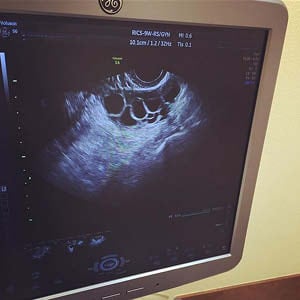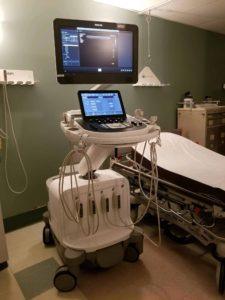This post was reviewed for medical accuracy by Rosalie Gunson, a Certified Registered Nurse Practitioner specializing in fertility care.
Soon after I found out I was pregnant, a friend made a point of warning me about the first ultrasound. “It will be internal, just so you know,” she said, like it was a major privacy violation. “Oh, I’ve probably done 30 of those already,” I replied. My friend was horrified.
Internal, or transvaginal, ultrasounds are done with a wand that is inserted into your body. Doctors use this type of ultrasound to check your ovaries, uterus, fallopian tubes, and other organs.
An internal ultrasound can also confirm a pregnancy weeks before it would be visible using the kind of ultrasound you typically see in movies.
If you’ve never had a transvaginal ultrasound before, you may wonder if it hurts. The good news is that transvaginal ultrasounds aren’t usually painful. Sometimes they are a bit uncomfortable, depending on the angle that the ultrasound tech is trying to get, but they shouldn’t hurt.
Definitely tell your ultrasound tech if you do feel pain, though. Pain can be a sign of some other medical condition, like endometriosis.

This kind of ultrasound is done later in pregnancy.
Why You Might Get a Transvaginal Ultrasound
Most women get a maximum of one transvaginal ultrasound in early pregnancy, and that’s it. But women who do fertility treatment get to be on a first-name basis with their sonographer.
Here are a few common reasons women get transvaginal ultrasounds:
-
- To confirm correct placement of an IUD
- To measure developing follicles and the uterine lining during fertility treatment
- To confirm a viable early pregnancy
- To diagnose gynecological problems, such as endometriosis, fibroids, or ovarian cysts
- To investigate the cause of unusual bleeding or pelvic pain
What You Can See on a Transvaginal Ultrasound
If you’re getting the ultrasound as part of fertility treatment, it’s probably to check for developing follicles. Each follicle contains an immature egg. (The eggs themselves are WAY too small to be seen on an ultrasound.)
The ultrasound tech will measure the diameter of the follicles, as well as the thickness of your uterine lining. This an important measurement for fertility, since you want a nice thick lining to support implantation.
At the time that you trigger ovulation, most doctors like to see at least one follicle in the 18mm to 20mm range, and a uterine lining of at least 7-8mm. For more information about the importance of a good endometrial lining, check out my post Can You Get Pregnant With a 5 mm Endometrial Lining? (Spoiler alert: It’s not very likely.)

How many ultrasounds you get in a medicated cycle depends on how thoroughly you’re being monitored and how well you’re responding to the treatment.
Generally, women taking injectable fertility medications will be sent for more frequent ultrasounds than women taking Clomid or letrozole, because the injectable meds are much stronger. Your doctor will want to make sure that you are not producing too many follicles too quickly.
For more information about these medications, check out my posts Are Letrozole and Femara The Same Thing? and When to Consider Moving on to Injectable Fertility Meds.
It’s not unusual to have three or four ultrasounds in one cycle, most of them in the second week. For example, you might have a baseline scan on CD 1-3 to make sure that you don’t have any residual follicles from the previous cycle.
Then, you might have scans on CD 10, CD 12, and CD 14 to check on the developing follicles and determine when to do the trigger shot. You might have even more scans if you have a slow response to the medication.
If your ultrasound is to confirm pregnancy, you should be able to see the yolk sac and possibly the fetus as early as 6 or 7 weeks. The ultrasound may also measure the baby’s heartbeat. You’ll be able to see the flicker of the heartbeat on the monitor, although you will not be able to hear the heartbeat until you get your first Doppler a little later on.
Understandably, ultrasounds can be nerve-wracking experiences for women with a history of pregnancy loss. For more info and support, see TTC a Rainbow Baby: Overcoming Recurrent Pregnancy Loss.
Assuming the pregnancy is going well, an early ultrasound can also help your doctor determine your due date. For more info on due dates with fertility treatment, head over to Are Due Dates More Accurate With IVF?
You may be given a printout of the ultrasound images to take with you. No one really wants to take home images of their follicles, but a baby is way more exciting!
If you are getting the ultrasound due to a medical concern, the ultrasound will show certain kinds of abnormalities in the uterus and ovaries. You may need an HSG to further diagnose the problem. For more about this test, see my post Does an HSG Hurt? What to Expect.
What to Expect When You Get a Transvaginal Ultrasound
Like I said above, I’ve probably had 30 of these ultrasounds. It’s really not as awkward as it sounds! If you’ve never had one before, I’ll walk you through it.
Your ultrasound will probably be done at your ob/gyn’s office or your fertility clinic. Hospitals also have ultrasound machines, but primary care offices typically don’t. (See Can My PCP Prescribe Clomid? and Graduating from an RE to an OB for Prenatal Care for more info about the different medical professionals you might see on your fertility journey.)
To begin with, you should probably pee right before you get the ultrasound. You’ll be more comfortable, and it will make certain things easier for the technician to see. It’s a good idea to ask about this, though, in case they would prefer you not to have an empty bladder for the scan.
You’ll have to undress from the waist down. You’ll lie down with a sheet over your lap, as you would for a Pap smear. Then, a lubricated wand (known online as “the dildo cam”) is inserted into your body.
Don’t worry — only the first few inches actually go in, not the whole thing! The ultrasound tech will aim the wand so that she can get a good view of the appropriate areas.
 The ultrasound machine bounces high-frequency sound waves off the organs in the pelvis. The computer turns that information into an image on the screen. Usually you will be able to watch the screen as the scan is happening, so you’ll see what the sonographer sees.
The ultrasound machine bounces high-frequency sound waves off the organs in the pelvis. The computer turns that information into an image on the screen. Usually you will be able to watch the screen as the scan is happening, so you’ll see what the sonographer sees.
The ultrasound tech may chat with you, especially if this is not your first rodeo, but ultimately it will be your doctor who interprets the results. The whole thing will probably take 15-20 minutes, depending on what the ultrasound is for.
Then What?
After my ultrasounds, I got dressed and went back to the waiting room. In a little while I’d get called back to an exam room to confer with the infertility nurse or the doctor and discuss whatever plan of action they recommended.
For example, if it was a CD 10 scan, we would talk about how many follicles there were, when I’d come in for the next scan, and what doses of which medications I would take in the meantime. I never left the office wondering what the scan showed or what I was supposed to do next.
Depending on how your doctor’s office or clinic works, you may be sent home and told to wait for a call to review the results and the game plan.
Can You Get a Transvaginal Ultrasound if You’re Having Your Period?
Yes, you can have the ultrasound done while you’re bleeding — you just have to remove the tampon if you’re using one. This happens all the time, so you don’t need to feel awkward about it.
As I said above, infertility patients are often sent for a baseline scan during days 1-3 of their cycle, when they would be having their period. It’s also common for women to get these ultrasounds when they are bleeding for some other reason, including a potential miscarriage.
So don’t worry about weirding out your ultrasound tech by showing up to the scan on your period. It won’t even faze her, I promise!
Should Your Partner Come With You For Your Transvaginal Ultrasound?
Once the world re-opens, whether you want to bring someone with you is entirely up to you. Some women want their partners with them every step of the way, while others would rather go to their appointments on their own — especially appointments that do not involve wearing pants.
Remember that if you’re doing fertility treatment, it’s likely that you will need many of these scans, and some of them will be on short notice. It may not be practical for both of you to leave work every time you need an ultrasound.
I chose to go to most of my infertility and prenatal appointments on my own. My husband came with me for only one internal ultrasound, which was around 6 weeks of pregnancy.
That was a big day for us, because we walked in not knowing if I was pregnant with one, two, or three babies. We’re the only twin parents I know who were relieved to find out they were having “only” twins!
The Bottom Line
I hope you’re feeling a little more comfortable with the prospect of a transvaginal ultrasound. It’s not exactly a great time, but it’s totally worth it in the end!
FURTHER READING: Ultrasound Exams FAQ — American College of Obstetricians and Gynecologists

This post was last updated in March 2025. Most of its content was written in 2020.



 I’m Jenn! Here I am with my beautiful twin boys. My pregnancy was possible thanks to fertility treatment for PCOS.
I’m Jenn! Here I am with my beautiful twin boys. My pregnancy was possible thanks to fertility treatment for PCOS.


